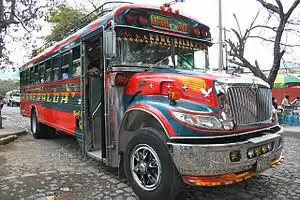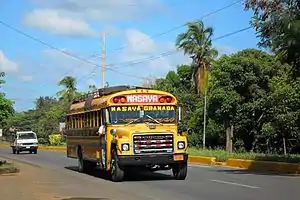Chicken bus
A chicken bus (Spanish: "camioneta de pollos" or "trambilla", the latter a hypercorrection of "tranvía") is a colloquial English name for a colorful, modified and decorated bus that transports goods and people between communities in various Latin American countries, especially Honduras, Guatemala, El Salvador, Nicaragua, Costa Rica and Panama. In the latter country, chicken buses are also known as "Diablos Rojos"[1]


The base vehicle is usually a retired North American school bus on a light or medium truck chassis. The word "chicken" may refer to the fact that the buses are often crammed with passengers not unlike a truck load of chickens,[2] or to the fact that Central Americans occasionally transport live animals on such buses–a practice that visitors from other countries often find remarkable.[3][4] In Panama, the base vehicle can also be a passenger Toyota HiAce or Toyota Coaster or similar and is often left painted white. If a Toyota Coaster is used, the bus is known locally as a "Chiva", and if a Toyota HiAce is used, the van is called a "busito" instead.
Operation
Often two young men will partner in the operation of a bus, one of whom will have his license, while the other dubs himself the ayudante or "helper". The ayudante is responsible for passengers and luggage, collecting money, and organizing the suitcases, livestock, or produce, etc. onto the roof of the bus–often while in motion. Loudly announcing destinations the bus is reaching is also a responsibility.
Some buses sport vibrant paint including the bus's name and permanent route. Often religious imagery and verbiage is also employed. Such forms of transport are completely stuffed with passengers (whenever possible) and then hard-driven to their destinations at top speed. Some countries, such as Nicaragua subsidize their chicken buses and establish maximum prices, which often end up being the de facto price for the route. Still, unlike bus drivers in Europe, the drivers are usually self-employed or members of cooperatives and keep the fares to cover (part of) their expenses, thus motivating the above-mentioned overloading with passengers.
In Panama, these kind of buses are more commonly known as "Buses piratas" (pirate buses) since they are considered by the government to be illegal, and there have been cases of these buses being operated by drivers that don't have the adequate driver's license. They may also opt to use smaller buses that don't require a such a special (and in turn, expensive) license, in addition that a smaller bus uses less fuel and can increase revenue and profits considerably. These kind of buses were supposed to be phased out in around late 2011-early 2012, to be replaced by the "Metro Bus" system of transport. However, they soon re-emerged, as in the start, the service offered by the new system was considered by many to be bad, with buses often overcrowded in peak hours. This was facilitated by the fact that the import of North American style school buses was still allowed, but only for private companies. Soon, the old system of transport re-emerged, and was soon declared illegal by the Panamanian government. Efforts to stop this system of transport have been met with little success. The import of such North American style buses was soon banned as well, for all companies, organizations and individuals, with no exceptions.
References
- http://www.educapanama.edu.pa/?q=articulos-educativos/los-diablos-rojos-cultura-panamena-popular-rodante
- "Chicken Buses of Guatemala". Amusing Planet. 14 October 2012.
- Morrison, Tim (4 September 2004). "Hop a 'chicken bus' to rural Honduras: A trip into the countryside is a challenge but I'm rewarded with cloud forests, pristine rivers and giant waterfalls". The Vancouver Sun.
- Collins, Tracy (30 September 2006). "LETTER FROM GUATEMALA SOJOURN IN GUATEMALA; A volunteer discovers something of herself in her travels to Antigua". Bangor Daily News.
External links
| Wikimedia Commons has media related to Buses in Guatemala. |
| Wikivoyage has a travel guide for Chicken buses. |